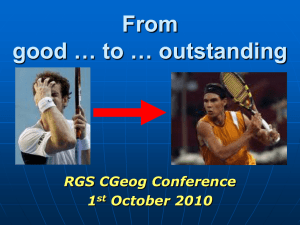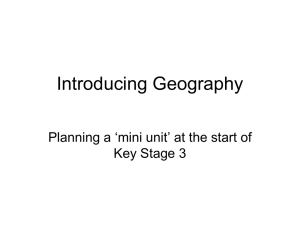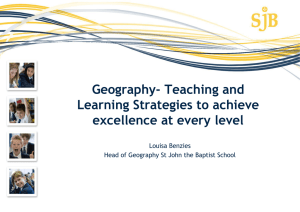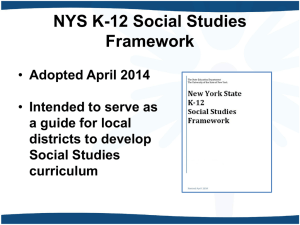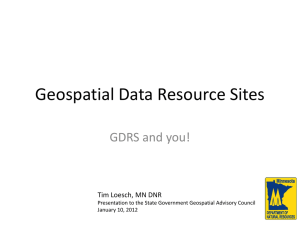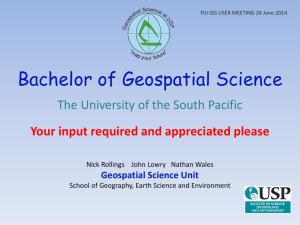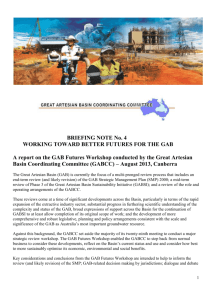Scott.ppt
advertisement
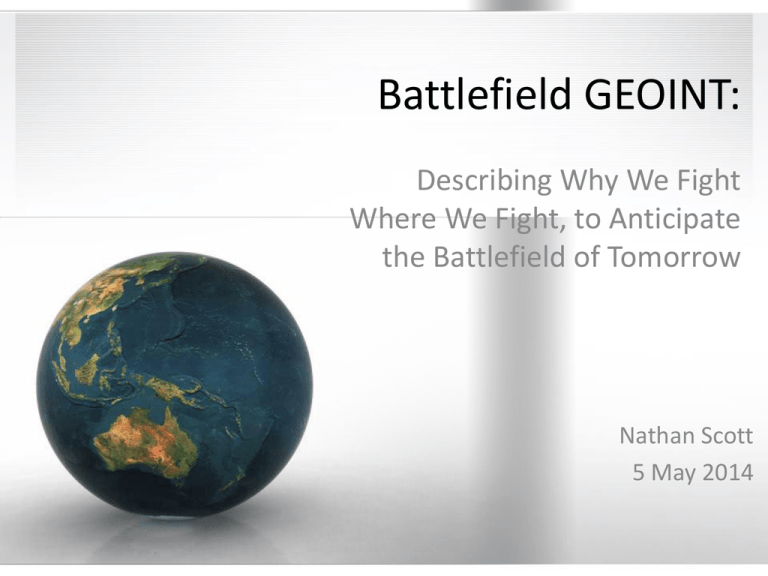
Battlefield GEOINT: Describing Why We Fight Where We Fight, to Anticipate the Battlefield of Tomorrow Nathan Scott 5 May 2014 Agenda • • • • Problem Statement Approach Assumptions - Geographic Spaces Re-thinking Battlefield Analytics - Geospatial Analysis of the Battlespace (GAB) – Physical Geography – Behavioral Geography – Cognitive Geography • Timeline Problem Statement • The US Army utilizes an antiquated analytical process to analyze the battlespace. Focusing on the unified use of geospatial technologies and interconnected geographic spaces would best align the Army to understand the battlesapces of the future. Approach • Technical Spatial Analysis Turned to Hypothetical • Redefining What We Know – Rebalance and incorporate best practices • Merge Fields – Geography - Geospatial – Mathematics – Statistical – Psychology – Human cognition (why we do what we do) Assumptions – Geographic Spaces • Physical Geography – What Mother Nature presents in the battelspace – Traditional terrain analysis • Behavioral Geography – What humans CAN do given the Physical Geography – Comprehensive identification of all possibilities • Cognitive Geography – What humans CHOOSE to do given the Behavioral Geography possibilities Geospatial Analysis of the Battlespace (GAB) • Align Battlespace With Holistic Concept – Everything has an impact on everything else (Physics!) • Utilize Geospatial Concept/Theory – Technological approach with geospatial thinking – Focus on databasing info for dynamic modeling • Non-linear Battlespaces – Physical, Behavioral, Cognitive cyclic and always updating Physical Geography • Traditional Analyses Work – Slope, soils, vegetation cover • Transition to using established NSG databases – Constant and consistent updates • Standardize analyses via models/tools – GIS community best practices • Goal to create consistent outcome for all users • Identifies what Mother Nature is providing in the Battlespace Behavioral Geography • Bridges the gap between templating and geospatial analyses • Focus is on using GIS to determine human/machine physical interactions w/ Physical • Requires physical based modeling to determine all possibilities • Output is a comprehensive identification of all basal human interactions (Behavioral) with Nature (Physical) Cognitive Geography • Historical intent was to determine threat courses of actions • Shift in view to using GIS/GEOINT to predict what an threat is most likely to do – Probability based approach – Utilize “big data” and psychology to create probabilistic models • Focus in on determining, from the Behavioral “list” what a threat is most likely to do Future of GAB • Future work needs to focus on Cognitive Geography – GIS, mathematics, and psychology merge – Begin to model what we know of human behavior • Comprehensive system-based approach – Sensor to Database to Algorithm to Interface • Analytical re-thinking of how objects interact in space – Linear? Chaotic? Probabilistic? Timeline • May 2014 – Finish up research on Cognitive and Psychological human interactions – Incorporate final research into GAB future focus – Continue Peer and Community Review of working document • June 2014 – Finalize all documents – Re-Distribute for final reviews • August/Sept 2014 – Present research Questions ?





